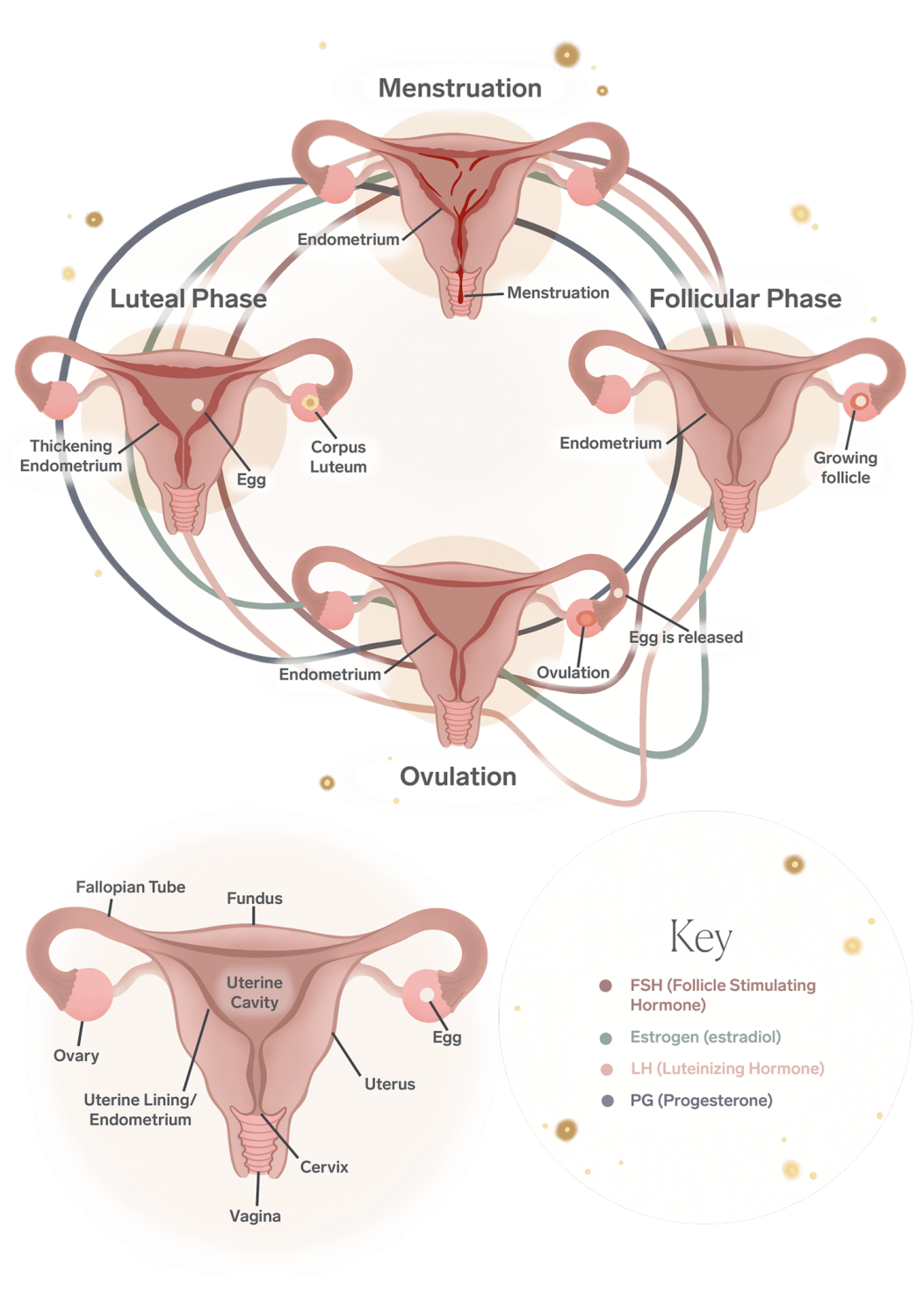How to track your menstrual cycle and get in tune with your body
Helping you figure out your follicular from your luteal.
PSA: your period is just one phase of your menstrual cycle. There’s a real myth around our menstrual cycle lasting a month (or four weeks) but every body is different. A typical period can last between 8-13 days, which throws that whole ‘one month per cycle’ myth off balance (and you can find more on ‘regular' vs 'irregular’ cycles here).
TL;DR
There are two phases in your cycle, follicular and luteal, along with two key events: one at the start of your cycle - menstruation - and one around the middle - ovulation.
Learning how to track your menstrual cycle (using an app, old school with a pen and paper, on your calendar) will help you figure out where you're at in your cycle. It's also important to note that sometimes a cycle length may vary, whether it's from having irregular periods or going through life changes.
We do also flag that some cycle tracking app have specific data policies, so please do be sure to check the smallprint before using them, particularly in a post-Roe v. Wade world. Friendly reminder that not all support systems were created equal, sadly.
You need to pay attention to your body – notice what physical feelings you get when you’re in each phase.
A reminder that there’s a difference between general cycle awareness, and tracking for contraception - be sure to not confuse the two.

Phases and Key Moments
Menstruation
Follicular Phase
Ovulation
Luteal Phase
Menstrual cycle tracking is important to understanding your body and the phases it goes through, whether you have regular periods or irregular periods. Working out which phase you're in will get easier over time. Tracking your cycle is the best way to fine-tune this process - whether that's through an app, on your calendar, or just with a pen and paper (we respect the old school approach - as long as it doesn't get lost).
Tracking Your Cycle
There’s An App For That
For some reason tracking your cycle wasn’t a thing you’d do as a teenager, and period tracking apps really came into their own only in the last decade. Essentially you’re logging when you get your period, how your body is feeling and how heavy your menstrual bleeding is.
The longer and more consistently you track your period, the more in tune it will become with your cycle, learning when you’re about to ovulate, when you’re about to bleed and generally letting you know when you’re in which phase.
We recommend period tracking apps like Clue, Flo Period Tracker or Moody Month. *As of June 2022, we would like to flag that we strongly urge you to read the small print when signing up to cycle tracking apps, to ensure you are happy with data privacy policies. A gentle reminder that in a post Roe V. Wade world, it's important to tread with caution where technology and reproductive health are concerned.
Remember: a tracking app will do a lot of things, but won’t necessarily be 100% accurate in telling you what phase you’re in. Your body changes and algorithms aren’t always the best (we see you Instagram ads). But the longer you track, the more cycle history you’ll build. Don’t let your phone do all the work. Internalize that information.
New Calendar Event: Ovulation
If you’re more likely to check your calendar than remember to log your period on an app (it happens), regularly marking the day when you start and finish your period is helpful — heads up, it doesn’t have that magical algorithmic result (i.e. an app reminding you when your period might be after learning about you — but we totally get it if inputting your data into an app seems a bit daunting). Just put a mark, sticker or drawing on the day your period starts. Whatever helps you to embrace it.
But Remember Filofax?
We’d recommend using either an old-fashioned journal (or on your computer/phone if that’s easier for you) to mark when your period starts, and any changes you’re personally interested in tracking, like how heavy your bleeding is, or any physical or mental symptoms throughout your cycle 🩸.
Pay Attention To The Signs
There’s more that goes on in our bodies apart from sore breasts, pelvic cramps and [insert length of bleeding here]. There are a few things you can pay attention to that will help you figure out your cycle:
Cervical fluid: during each phase or moment of your cycle, your cervical mucus (aka discharge) will have a different consistency. In the follicular phase? Expect dryness in the first few days after your period ends. While you’re ovulating it’s likely to be wetter, clearer and more stretchy. Feeling luteal? Here’s when your discharge can become stickier and dry.
Temperature: for the super keen. Your body temperature changes in response to changes in your reproductive hormones. Before ovulation, your temperature is usually between 97.2°F and 97.7°F. The day after ovulation, your temperature will typically increase by 32.1°F, then stay like this until menstruation.
Cervical position: we’d recommend getting to know your cervix – just remember to wash your hands and cut those nails. Otherwise head to your health care provider if you’ve never checked your cervical position yourself - and perhaps learn to understand your cervix yourself for future checks. The simple overview is that your cervix is usually high around the time of ovulation; and low the rest of the time.
Ovulation pain: ever noticed a little twinge before you start your period? That’s ovulation pain, and about 1 in 5 people feel it. It can last hours to days and is typically felt on the side of the ovary releasing an egg. We recommend applying a period patch on your uterine area to help soothe any ovulation-related discomfort.
Ovulation tests: you can also do ovulation tests at home to see when you’re ovulating. These test trips work by measuring the luteinizing hormone (LH) in your urine.
To get a really good idea of your pattern, try to track your cycle (feelings, sensations, physical and mental factors) along with your usual signals (like mood or tenderness that you’ve noticed before) more closely for at least three cycles.
And just a reminder: there’s a difference between tracking your period to be generally aware of your cycle, versus tracking for contraception/pregnancy. Fertility tracking usually means specific daily routines, like taking your temperature each morning, and calculating temperature differences over several days to track the fertile window. When tracking like this, there’s a big emphasis on ovulation (as that’s when you’re most likely to get pregnant); whereas when you’re tracking your whole cycle, it’s important to pay attention to your whole cycle.
To learn more about what each phase *feels* like, check out our guides to Menstruation, the Follicular Phase, Ovulation and the Luteal Phase.
Your hormones can be complex and unpredictable. That’s why we’re here, on The Regular, to do what’s long overdue - to demystify what’s going on with our reproductive systems, our hormones and our whole cycle.
We’re here to support your day-to-day queries serving useful content that is uncomplicated and unbiased. No topic is too complicated or too specific for us to address/focus on.


